Rich in culture and tradition, South Korea is where ancient customs and modern innovations unfold alongside each other. Traditional Korean dress is only one of many of Korea’s cultural treasures, but it exemplifies both the country’s historical legacy and aesthetic sensibilities. The traditional dress of South Korea is called hanbok. Each element of the hanbok represents the essence of South Korean identity steeped in ancestral pride, honour for the struggles of the past and hopeful expectations for the future.
The hanbok has been worn for centuries by Korean men, women and children. It is not only a garment but is an expression of social class, family responsibilities and cultural identity. What makes it more than just an article of clothing are the tradition, culture, and history behind it. The traditional dress of South Korea embodies the values and daily lives of the Korean people through the flowing skirts and fitted jackets that make up each piece of the hanbok.
Traditional Dresses for Men
The design of the traditional dress of South Korea has maintained the traditional essence with some changes made to accommodate modern functionality requirements. The traditional dress may be called hanbok, but each component has a different term, use and meaning. Here is what each element of the hanbok is called.
1. Jeogori (저고리)
The jeogori is the basic top wear worn by South Korean men. It is a simple, straight cut jacket with a long sleeve and v-shape neck which is tied with a ribbon attached. Jeogori was worn both as outerwear and homewear. Jeogoris are available in many colors. However, the most commonly worn colour is white. Traditionally, jeogoris have a long length extending till below the waist. A more modern take on it is the Jeogori shirt, which is often worn by men as casual wear.
The jeogori is usually made from light, breathable materials. Commoners typically wore jeogoris made of hemp or mosi (fine ramie fabric) during summers, and for winters, they wore jeogoris made of wool or leather. On the other hand, men from a noble class or an upper class commonly wore finer, brighter-coloured jeogoris made of silk, switching to wool ones during winters.
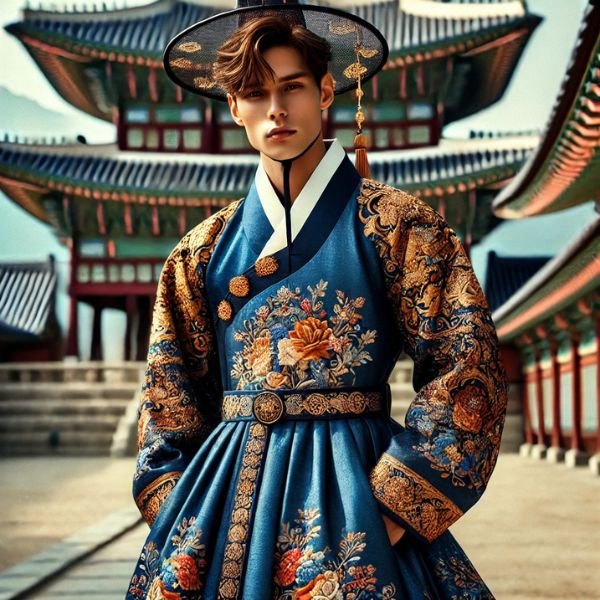
2. Baji (바지)
Baji refers to the bottomwear or pants worn with the jeogori. This type of pants is known for its relaxed fit and wide legs that enable free movement. Baji is usually fastened at the waist by a drawstring and may be secured with ties called the daenim at the ankles to give them a tapered appearance. Baji was generally an outer wear option for South Korean men. However, some women even wore a baji under their clothes as underclothes in the older days.
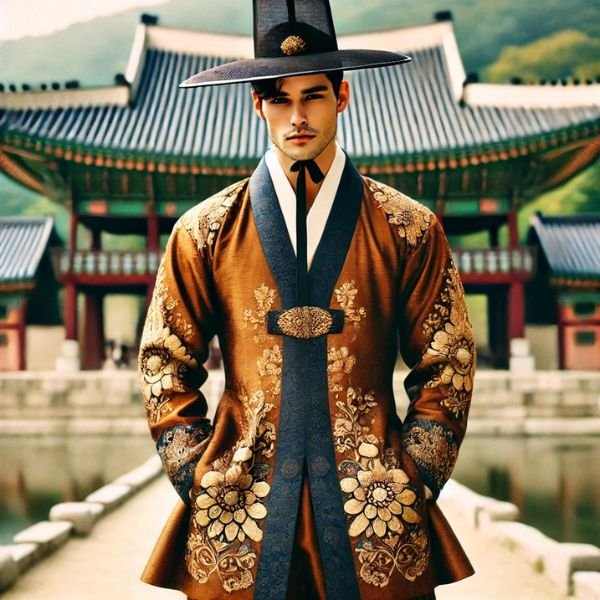
3. Durumagi (두루마기)
The durumagi is a wide and straight shaped traditional Korean coat that is worn over the jeogori and baji. Durumagis have long sleeves and ribbons on the front for fastening. Since the winters in South Korea can be quite harsh, the durumagi was designed to help commoners fend off the weather. The coat was also sometimes used as a housecoat by noble-class men. The main difference is that it was usually made of thicker materials, such as wool for commoners and silk for the noble class.

4. Baeja (배자)
A baeja is a fitted-long sleeve or sometimes sleeveless jacket worn on top of the jeogoris. Baejas are colourful and made of silk, cotton or wool. South Koreans living in colder regions of the country would often wear baejas with a fur trim for warmth. These jackets are often worn in festivals like Seollal (New Year), and special occasions like birthdays and weddings.
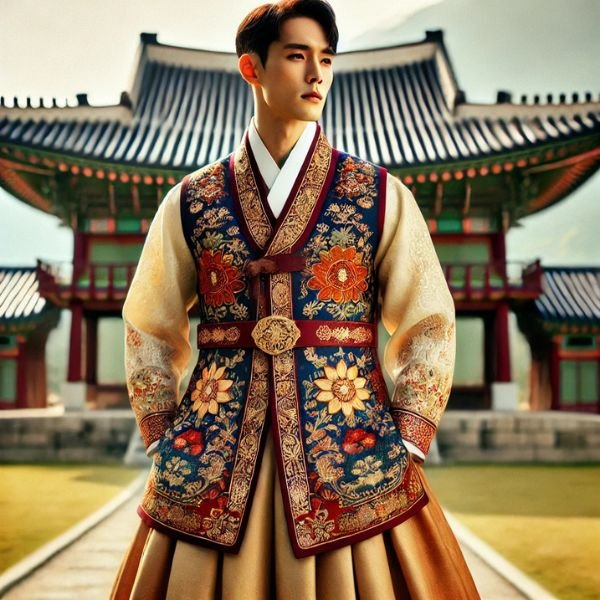
5. Gat (갓)
The gat is a traditional Korean hat for men, comprised of horsehair and bamboo. It has a wide brim and cylindrical crown, secured with a chin strap. The gat was a traditional symbol of social status and the gat would often be worn by scholars and officials.

6. Magoja (마고자)
The magoja is an outer jacket on top of the jeogori that was worn during the colder months. Longer cut and buttoned at the front, it provides more warmth and coverage.
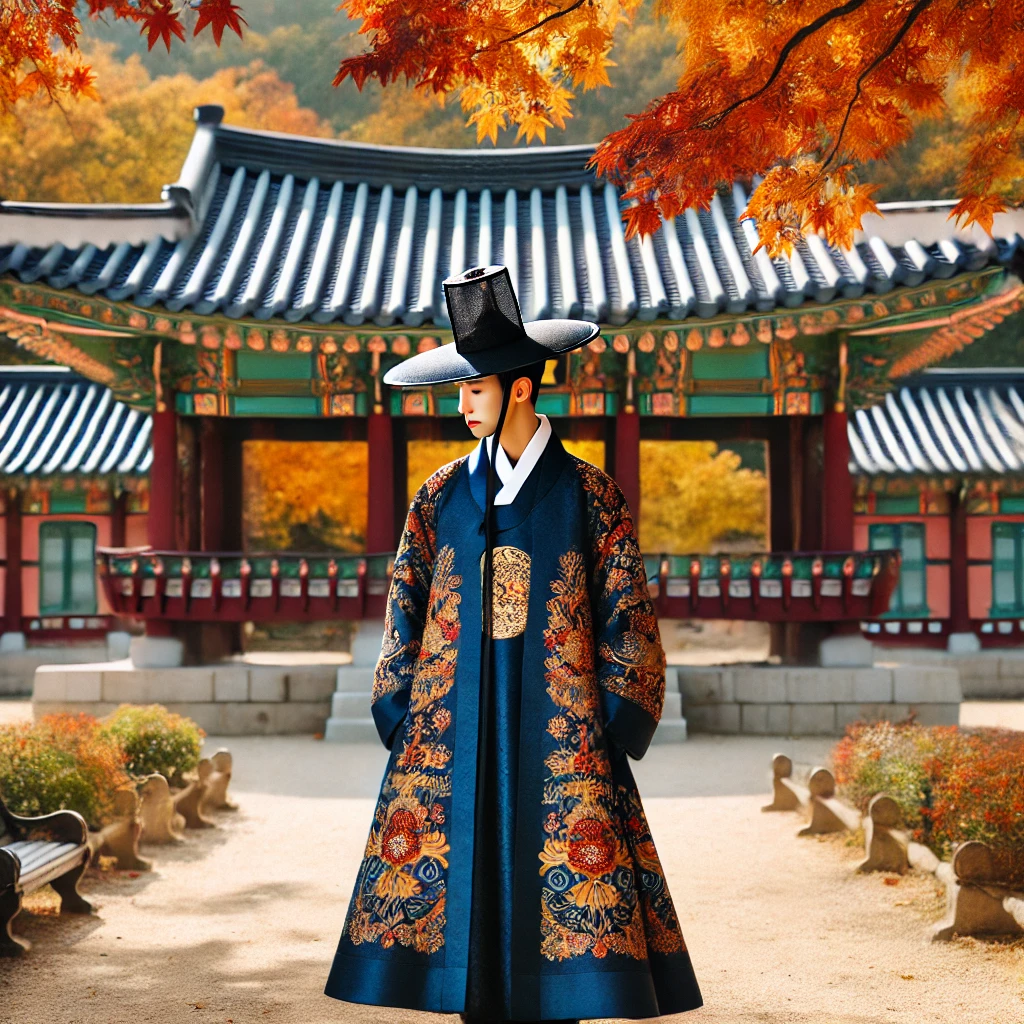
7. Beoseon (버선)
Beoseon are traditional Korean socks, usually made of cotton or silk. They are made to closely wrap the foot and are commonly worn with traditional Korean-cut shoes known as gomusin or hwahye.

Traditional Dresses for Women
The traditional dress for South Korean women is renowned for its grace and beauty, with flowing lines and delicate fabrics that highlight the elegance of the wearer. Here are the essential components of traditional Korean women’s clothing:
1. Jeogori (저고리)
Similar to the men’s version, the jeogori for women is a cropped jacket that features long sleeves and a V-shaped neckline. However, the women’s jeogori is often more fitted and may include decorative elements such as embroidery or intricate patterns.
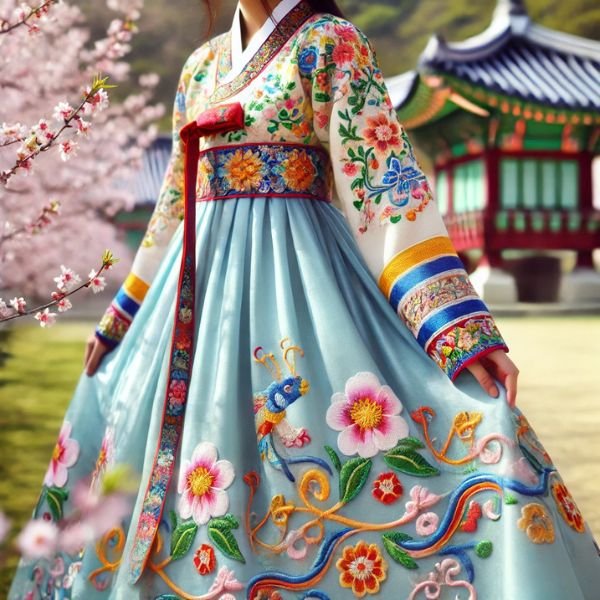
2. Chima (치마)
The chima is the traditional Korean skirt worn by women. It is a high-waisted, full-length skirt that is gathered and tied at the chest, creating a flowing and voluminous silhouette. The chima is often made from silk or other lightweight fabrics and comes in a variety of colors and patterns.

3. Beoseon (버선)
As with men’s attire, women also wear Beoseon, the traditional Korean socks, which are designed to fit snugly and provide comfort. Women’s Beoseon often have small hand-made embroidery on them. In the older days, it was tradition for mothers to gift embroidered socks to their daughters on their wedding day.
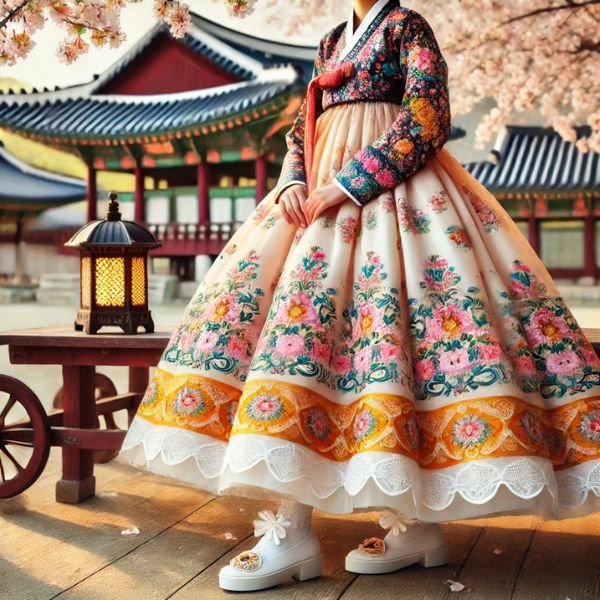
4. Durumagi (두루마기)
Women also wear the durumagi, the traditional overcoat, for additional warmth and protection. The women’s version is similar in design to the men’s but may feature more feminine touches, such as floral patterns or pastel colors.

5. Norigae (노리개)
The Norigae is a traditional dress of south Korea worn by women, typically attached to the waist tie of the chima. It consists of a decorative pendant or charm, often made from precious materials such as jade or silk. The Norigae is not only an ornamental piece but also holds cultural significance, symbolizing good fortune and protection.
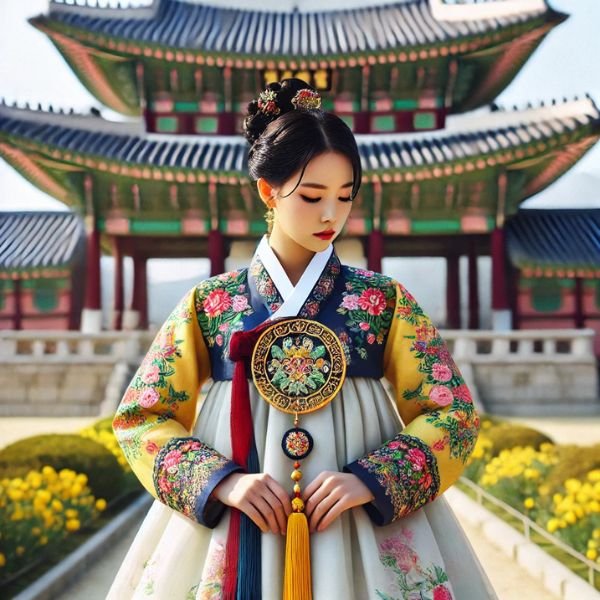
6. Binyeo (비녀)
The Binyeo is a traditional hairpin used to secure the bun in a woman’s hair. It comes in various designs and materials, including wood, jade, or metal, and often features intricate carvings or embellishments. The Binyeo serves both functional and decorative purposes.
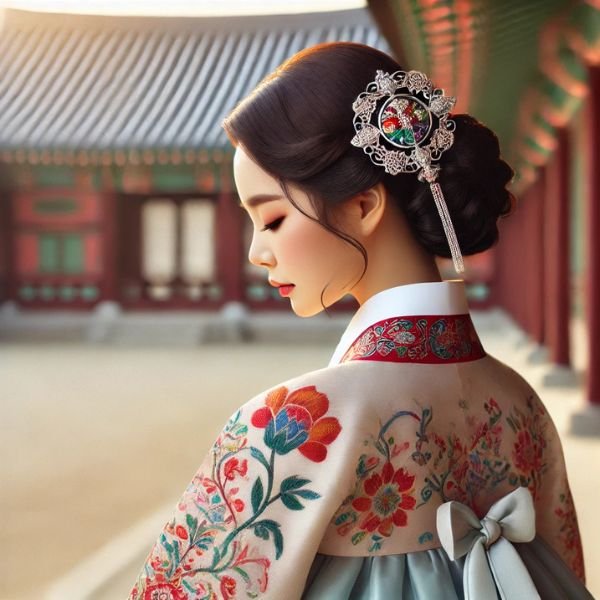
7. Dangui (당의)
The Dangui is a ceremonial jacket worn by women on special occasions. It is similar to the jeogori but is longer and more elaborately decorated, often with intricate embroidery or gold leaf designs. The Dangui is typically worn over the jeogori and chima.
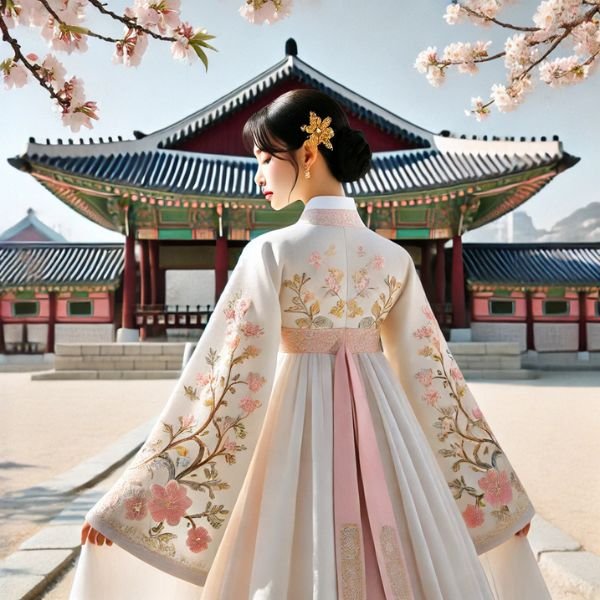
8. Hwalot (활옷)
The Hwalot is a traditional Korean bridal gown, worn by women during weddings. It is a long, ornate robe made from luxurious fabrics and adorned with elaborate embroidery, depicting symbols of good fortune, prosperity, and happiness. The Hwalot is worn over the jeogori and chima and is accompanied by other ceremonial accessories.

Traditional Dresses for Children
Traditional Korean clothing for children often mirrors the attire worn by adults but with added elements of color and playfulness to suit their youthful spirit. The garments for children are designed to be both comfortable and visually appealing, incorporating bright colors and whimsical patterns.
1. Kkachi Durumagi (까치두루마기)
The Kkachi durumagi, also known as the “magpie’s overcoat,” is a colourful overcoat worn by children during special occasions such as holidays and celebrations. It is characterized by its vibrant hues and contrasting borders, symbolizing prosperity and joy.
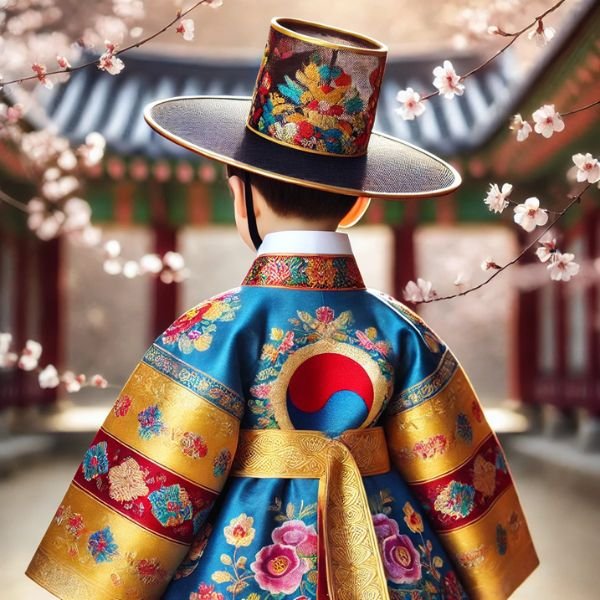
2. Bokgeon (복건)
The Bokgeon is a traditional hat worn by young boys. It is typically made from black silk and features a simple yet elegant design. The Bokgeon is often adorned with embroidery or small decorations and is worn to signify blessings and good fortune.

3. Hogeon (호건)
The Hogeon is another traditional hat, worn by young boys. It is similar to the Bokgeon but includes additional embellishments such as tassels and embroidered patterns. The Hogeon is worn to protect the child’s head and to ward off evil spirits.
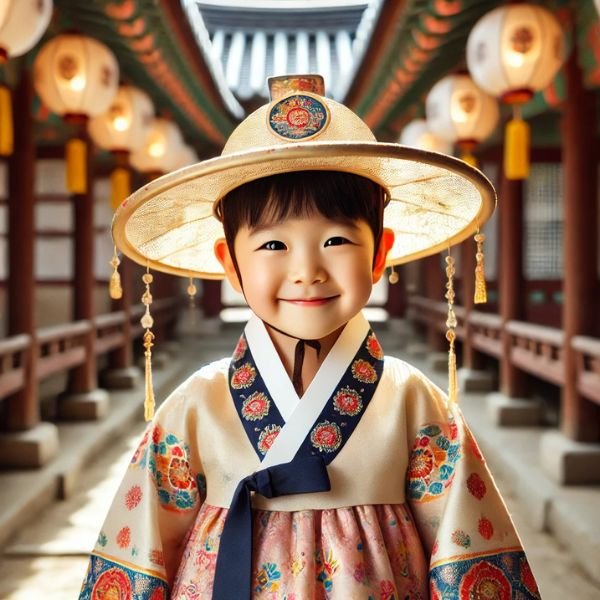
4. Gulle (굴레)
The Gulle is a traditional Korean headgear worn by young girls. Made from silk, the Gulle is decorated with colourful patterns and delicate embroidery. It is worn to celebrate the child’s well-being and to bring blessings for a prosperous future.

5. Hanbok (한복)
As with adults, children wear the hanbok, which includes the jeogori and chima for girls, and the jeogori and baji for boys. These garments are often more colourful and feature playful motifs to reflect the joyful nature of childhood.

Check Also: Traditional Dress of Japan
Conclusion
Traditional Korean clothing, or hanbok, is a timeless expression of the country’s cultural heritage and artistic craftsmanship. Each garment, from the elegant jeogori to the flowing chima, tells a story of Korea’s rich history and enduring traditions. While modern fashion has undoubtedly influenced contemporary Korean attire, the hanbok remains a cherished symbol of national pride and identity.
The intricate designs, vibrant colors, and meticulous attention to detail in traditional Korean clothing reflect the values and aesthetics of the Korean people. Whether worn by men, women, or children, the hanbok is a beautiful representation of Korea’s cultural legacy, a legacy that continues to be celebrated and preserved for future generations.
